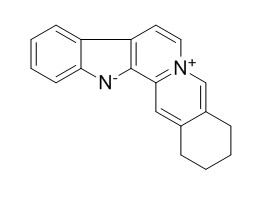Sempervirine
Sempervirine can unwind circular DNA, it shows selective inhibition of in vitro synthesis of cancer DNA .
Inquire / Order:
manager@chemfaces.com
Technical Inquiries:
service@chemfaces.com
Tel:
+86-27-84237783
Fax:
+86-27-84254680
Address:
1 Building, No. 83, CheCheng Rd., Wuhan Economic and Technological Development Zone, Wuhan, Hubei 430056, PRC
Providing storage is as stated on the product vial and the vial is kept tightly sealed, the product can be stored for up to
24 months(2-8C).
Wherever possible, you should prepare and use solutions on the same day. However, if you need to make up stock solutions in advance, we recommend that you store the solution as aliquots in tightly sealed vials at -20C. Generally, these will be useable for up to two weeks. Before use, and prior to opening the vial we recommend that you allow your product to equilibrate to room temperature for at least 1 hour.
Need more advice on solubility, usage and handling? Please email to: service@chemfaces.com
The packaging of the product may have turned upside down during transportation, resulting in the natural compounds adhering to the neck or cap of the vial. take the vial out of its packaging and gently shake to let the compounds fall to the bottom of the vial. for liquid products, centrifuge at 200-500 RPM to gather the liquid at the bottom of the vial. try to avoid loss or contamination during handling.
Nutraceuticals2022, 2(3),150-161
Int J Immunopathol Pharmacol.2019, 33:2058738419857537
Cytotechnology2022, s10616
Life Sci.2023, 317:121458.
Indian Journal of Science and Technology2023, 16(SP1):48-56.
Plants (Basel).2024, 13(23):3314.
Int J Mol Sci.202, 25(17):9246.
Int J Cosmet Sci.2022, doi:10.1111/ics.12827.
Molecules.2022, 27(4):1412.
Neurochem Int.2018, 121:114-124
Related and Featured Products
Exp Cell Biol. 1982;50(2):79-87.
Selective inhibition of in vitro synthesis of cancer DNA by alkaloids of beta-carboline class.[Pubmed:
7075859]
METHODS AND RESULTS:
The high template in vitro activity of native DNA from cancerous mammalian and plant tissues, compared to DNA from healthy tissues, enabled us to select substances which selectively inhibit cancer DNA synthesis. Among them, alstonine, serpentine, Sempervirine and flavopereirine, all alkaloids which belong to the Beta-carboline class, distinguish cancer DNA from healthy tissue DNA inhibit DNA in vitro synthesis when native DNA from different cancerous tissues or cells is used as template. They have practically no effect on DNA from healthy tissues. The inhibitory effect of alkaloids is due to their capacity to form an 'alkaloid-cancer DNA' complex which has been characterized by use of the Sephadex column.
CONCLUSIONS:
Evidence is presented showing that these alkaloids inhibit the initiation of DNA synthesis but not chain elongation. The stimulating action caused by carcinogens during cancer DNA in vitro synthesis may be prevented and reversed by alkaloids. Furthermore, the stimulating action of steroids during in vitro synthesis of hormone target tissue DNA might be neutralized by alkaloids. However, at relatively high doses, steroids reversibly compete with alkaloids for binding sites on breast cancer DNA. This is not observed with DNA from nonhormone target tissues.
Biochimie. 1984 Jan;66(1):31-41.
Physico-chemical investigation of the mode of binding of the alkaloids 5,6-dihydroflavopereirine and sempervirine with DNA.[Pubmed:
6713013]
METHODS AND RESULTS:
The mode of binding of 5,6-dihydroflavopereirine and Sempervirine to DNA has been investigated by absorption spectrophotometry, circular and electric linear dichroism, fluorescence and fluorescence polarization, viscosity increase of sonicated linear DNA and circular DNA unwinding. Although the spectroscopic properties of both compounds bound to DNA resembled those reported in our previous study of DNA complexes with two other alkaloids, and observed with planar intercalating compounds, only Sempervirine was able to unwind circular DNA. The latter drug however showed signs characteristic of aggregation at the surface of the polyion.
CONCLUSIONS:
The differences between the behaviours of the four alkaloids so far investigated by us are interpreted on the basis of different extent of penetration of the chromophore ring into the DNA helix.



